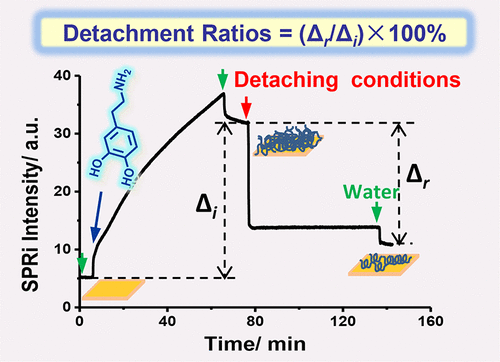Our official English website, www.x-mol.net, welcomes your
feedback! (Note: you will need to create a separate account there.)
Stability of Polydopamine Coatings on Gold Substrates Inspected by Surface Plasmon Resonance Imaging
Langmuir ( IF 3.7 ) Pub Date : 2018-03-05 00:00:00 , DOI: 10.1021/acs.langmuir.7b03143 Wei Yang 1, 2 , Chanjuan Liu 1, 2 , Yi Chen 1, 2, 3
Langmuir ( IF 3.7 ) Pub Date : 2018-03-05 00:00:00 , DOI: 10.1021/acs.langmuir.7b03143 Wei Yang 1, 2 , Chanjuan Liu 1, 2 , Yi Chen 1, 2, 3
Affiliation

|
Polydopamine (PDA)-based surface modification has been used in a variety of fields. However, a vague impression on the stability of PDA still exists due to a lack of systematic studies. To ascertain the issue and make better use of this surface modification method, a technique of surface plasmon resonance imaging (SPRi) was exploited to study the stability of PDA coated on gold surface. The results showed that PDA-coating stability was largely dependent on the pH of aqueous solutions, giving detachment ratios up to 66% and 80% at pH 1.0 and pH 14.0, respectively. However, increasing the ionic strength of aqueous solutions could reduce the detachment of PDA in strong acid and strong alkali conditions. Besides, organic solvents also made a difference on the PDA-coating stability. Among the tested 10 kinds of organic solvents, including n-hexane, toluene, ethyl ether, tetrahydrofuran, ethyl acetate, isopropanol, acetone, acetonitrile, dimethylformamide (DMF), and dimethyl sulfoxide (DMSO), DMSO caused the most serious detachment of PDA, up to 56%, followed by DMF with a detachment ratio of 31%. Ultrasonication caused less than 10% detachment of the coated PDA. It should be mentioned that the PDA coatings deposited on gold surface were not detached completely in all the test conditions, even at pH 14.0 (ca. 20% PDA retained). In alkaline conditions, detachment competes with further polymerization, which gave a slight increase of the SPRi signals at pH 9.0–11.0. Based on the obtained information about PDA-coating stability, thickness-controllable and alkali-resistant PDA coatings were prepared. Moreover, the alkali-resistant PDA coatings remained reactive to biomolecules, supporting further functionalization of PDA coatings.
中文翻译:

表面等离子共振成像技术检测金基底上聚多巴胺涂层的稳定性
基于聚多巴胺(PDA)的表面改性已在许多领域中使用。但是,由于缺乏系统的研究,对PDA的稳定性仍然存在模糊的印象。为了确定问题并更好地利用这种表面修饰方法,利用表面等离子体共振成像(SPRi)技术研究了涂在金表面的PDA的稳定性。结果表明,PDA涂层的稳定性在很大程度上取决于水溶液的pH值,在pH 1.0和pH 14.0时分离率分别高达66%和80%。但是,增加水溶液的离子强度可以减少PDA在强酸和强碱条件下的脱离。此外,有机溶剂也对PDA涂层的稳定性产生了影响。在测试的10种有机溶剂中,包括ñ-己烷,甲苯,乙醚,四氢呋喃,乙酸乙酯,异丙醇,丙酮,乙腈,二甲基甲酰胺(DMF)和二甲基亚砜(DMSO),DMSO引起PDA的分离最严重,高达56%,其次是DMF,其脱离率达31%。超声波导致涂层的PDA脱离少于10%。应当指出的是,即使在pH 14.0(约20%的PDA保留)下,沉积在金表面的PDA涂层也不能在所有测试条件下完全剥离。在碱性条件下,分离与进一步的聚合反应竞争,这在pH 9.0-11.0时使SPRi信号略有增加。根据获得的有关PDA涂层稳定性的信息,制备了厚度可控且耐碱的PDA涂层。此外,耐碱PDA涂层仍然对生物分子具有反应性,
更新日期:2018-03-05
中文翻译:

表面等离子共振成像技术检测金基底上聚多巴胺涂层的稳定性
基于聚多巴胺(PDA)的表面改性已在许多领域中使用。但是,由于缺乏系统的研究,对PDA的稳定性仍然存在模糊的印象。为了确定问题并更好地利用这种表面修饰方法,利用表面等离子体共振成像(SPRi)技术研究了涂在金表面的PDA的稳定性。结果表明,PDA涂层的稳定性在很大程度上取决于水溶液的pH值,在pH 1.0和pH 14.0时分离率分别高达66%和80%。但是,增加水溶液的离子强度可以减少PDA在强酸和强碱条件下的脱离。此外,有机溶剂也对PDA涂层的稳定性产生了影响。在测试的10种有机溶剂中,包括ñ-己烷,甲苯,乙醚,四氢呋喃,乙酸乙酯,异丙醇,丙酮,乙腈,二甲基甲酰胺(DMF)和二甲基亚砜(DMSO),DMSO引起PDA的分离最严重,高达56%,其次是DMF,其脱离率达31%。超声波导致涂层的PDA脱离少于10%。应当指出的是,即使在pH 14.0(约20%的PDA保留)下,沉积在金表面的PDA涂层也不能在所有测试条件下完全剥离。在碱性条件下,分离与进一步的聚合反应竞争,这在pH 9.0-11.0时使SPRi信号略有增加。根据获得的有关PDA涂层稳定性的信息,制备了厚度可控且耐碱的PDA涂层。此外,耐碱PDA涂层仍然对生物分子具有反应性,











































 京公网安备 11010802027423号
京公网安备 11010802027423号